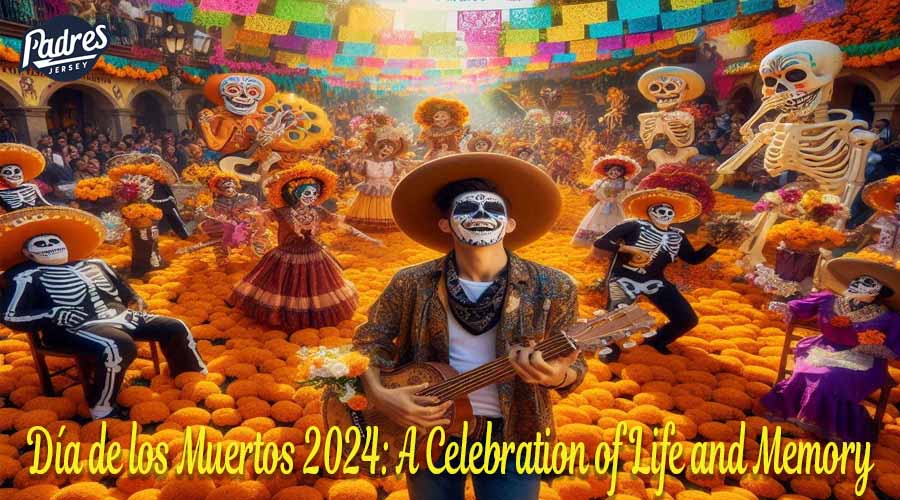Blog Padres Jersey
Día de los Muertos 2024: A Celebration of Life and Memory
Every year from October 31st to November 2nd, people across Mexico and various parts of the world gather to honor Día de los Muertos, or the Day of the Dead. This vibrant holiday is not a time for mourning, but a festive celebration that remembers loved ones who have passed on. Día de los Muertos combines pre-Hispanic rituals with Catholic traditions and has become an iconic symbol of Mexican culture. In 2024, Día de los Muertos promises to once again be filled with color, music, and heartfelt tributes to family and friends, reflecting the deeply rooted Mexican belief that death is just another part of life’s journey.
The Origins of Día de los Muertos
Image is for illustration purposes only
Día de los Muertos has ancient roots that go back thousands of years to the Aztecs and other indigenous cultures in Mexico. These groups believed that death was not an end but rather a continuation in the spiritual world. Spirits were thought to visit the living, and people celebrated these visits as joyful reunions. When the Spanish arrived in Mexico, they brought Catholic beliefs, which blended with indigenous traditions to shape the modern Día de los Muertos. By the 20th century, Día de los Muertos had evolved into the celebration we know today, marked by traditional altars, vibrant costumes, and festivities.
Traditional Elements of the Celebration
Image is for illustration purposes only
The heart of Día de los Muertos lies in its traditions, each one filled with symbolism and cultural significance. Ofrendas, or altars, are central to the holiday. Families create ofrendas in their homes or at cemeteries to welcome spirits back to the land of the living. These altars are decorated with photos of the deceased, candles, marigold flowers, papel picado (colorful paper banners), and offerings such as food, drinks, and cherished belongings. Each item placed on the ofrenda has meaning; marigolds, known as the “flower of the dead,” are believed to guide the spirits with their bright color and scent.
One of the most recognizable symbols of Día de los Muertos is the calavera (skull) and, in particular, the calavera makeup and sugar skulls that people create. Sugar skulls are colorfully decorated and placed on altars as offerings, while calavera makeup allows people to take on the appearance of a skeleton, symbolizing the connection between life and death. The figure of La Catrina, a sophisticated skeleton dressed in elegant attire, has become an icon of the holiday. Created by Mexican artist José Guadalupe Posada, La Catrina embodies the idea that death does not discriminate based on social status.
The Celebrations Across Mexico
 Image is for illustration purposes only
Image is for illustration purposes only
Different regions of Mexico have unique ways of celebrating Día de los Muertos. In Oaxaca, for instance, residents celebrate with vibrant parades, candle-lit cemetery visits, and traditional food like mole. In Michoacán, the island of Janitzio hosts one of the country’s most famous Day of the Dead celebrations. People row boats across the lake with candles to the island’s cemetery, where families gather to keep vigil overnight. Each community brings its own customs and traditions, adding to the diversity and richness of the holiday.
In Mexico City, the Día de los Muertos parade has become an annual event, attracting locals and tourists alike. Participants dress as skeletons, Catrinas, and other characters, creating a captivating, colorful procession through the streets. This event has grown in popularity since it was featured in the James Bond film Spectre, and it continues to be a spectacular display of Mexican culture.
Día de los Muertos 2024: Honoring Loved Ones, Preserving Traditions
In 2024, Día de los Muertos will be celebrated with the same spirit of love and reverence that has characterized the holiday for generations. Many people believe that Día de los Muertos is a time when the barrier between the living and the dead is thinnest, allowing for a momentary reunion with loved ones who have passed away. This unique perspective on death is what makes Día de los Muertos special—it’s a holiday that confronts mortality, celebrates life, and preserves memories.
Whether through vibrant parades, quiet cemetery gatherings, or simple ofrendas at home, Día de los Muertos 2024 will bring people together to share stories, memories, and traditions. It’s a reminder that while death may separate us from those we love, our connection to them endures. As families gather this year, they’ll not only honor the dead but also celebrate the beauty of life—a fitting tribute to a holiday that continues to bring comfort, joy, and a sense of community across generations.

